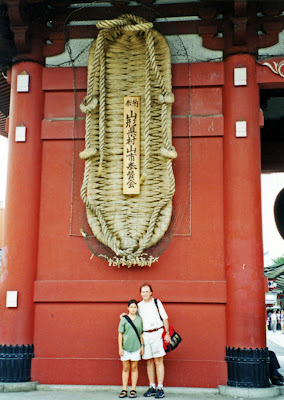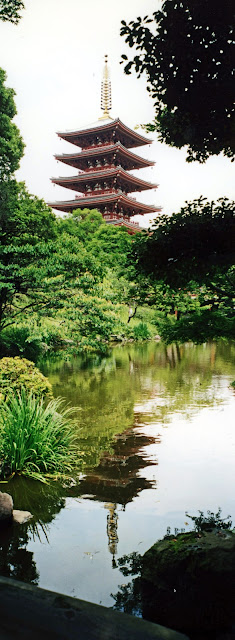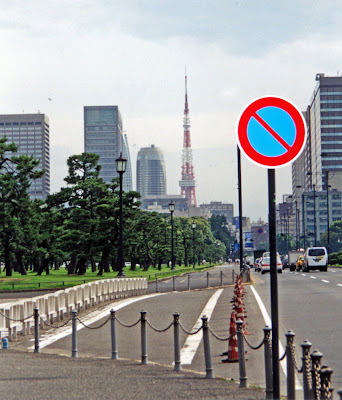We woke up at 6:30 am. Kent went down to the bath, and stopped for coffee in the lobby sitting area.
For breakfast, we returned to our private dining room. Salmon, fruit, a stew, salad, dried fish, tofu, dried seaweed, egg, taro, pickles, veggies, and green tea.
At 9:00 am, the hotel bus took us to the Tobu Railway train station. We passed the Kanaya Hotel up on the hillside above the Shin-kyo/bridge. It was a Nikko landmark, a rambling Victorian owned by the same family for a hundred years, who have hosted royalty and VIP from around the world. Apparently Tamiko’s dad had stayed at this hotel, at a time when the U.S. military could take over such properties for their exclusive use.
At the entrance to the hotel was a statue of Masatana Matsudaira, the feudal lord who planted all the cedars.
L.T.D. Express Specia
Kent went in search of an English-language newspaper, as Aunt Kyoko straightened out our tickets, which were for a train not on the schedule board.
We ended up on the L.T.D. Express Specia train leaving at 9:55 am. We had seat assignments, although the train was rather empty. This was the super deluxe express to Tokyo, with airline-like seats including outlets for earphones. We used our Northwest Airlines earphones to listen in on the train’s sound system.
 |
| L.T.D. Exprss Specia train |
The footrests folded down in two-stages, one for stockinged feet, and one for shoed feet.
This area of Japan seemed to have many grafted azaleas, and more fruit trees than other areas we have been through.
Saw another driving school, and a few solar heaters on the rooftops of houses.
Senso-ji
The Specia arrived in Asakusa, in northern Tokyo, about 11:45 am. We walked a couple blocks from the station to the pedestrian shopping street of Nakamise-dori, which led from the main gate to the inner gate of Senso-ji.
 |
| Shaded part of the Nakamise-dori shopping street |
The shops were originally leased to townspeople who cleaned and swept the grounds of the temple. Although the shops now belong to the government, the leases are, in effect, hereditary, and many of these shops have been in the same family since the Edo-period.
We came to the Hoze-mon, a 2-story gate that served as a repository for the sutras, or Buddhist texts, and other treasures of Senso-ji.
 |
| Hoze-mon with large paper lantern |
 |
| Inner side of Hoze-mon/Gate |
There were two guardian gods in the niches, and should they ever decide to take a stroll, there was an enormous pair of sandals hanging on the back of the gate. The sandals were a gift of the Yamagata Prefecture, famous for its straw weaving.
 |
| Brynne and Kent with huge pair of sandals |
Through the gate, to the left was a pagoda, and straight ahead was the Main Hall. Both these buildings were concrete replicas of originals burned in 1945. It took 13 years to raise the money to restore Senso-ji, which was important for worship. Kabuki actors come here before their theater season, and sumo wrestlers before their tournaments to pay their respects.
A large red paper lantern in the Main Hall was donated by geisha organizations. The Main Hall was 115-feet long, and 109-feet wide. Since the inner floor was made of concrete, you could enter wearing shoes.
The ceiling was painted by two contemporary masters of Nihonga, traditional style painting. The dragon was by Ryushi Kawabata, and the motif of angels and lotus blossoms was by Insho Domoto.
Senso-ji is supposed to have a holy image of Kannon buried deep under the temple.
To the left of the Main Hall was a 5-story pagoda, and to the right was Asakusa Jinja, a shrine to the Hikonuma brothers and their master Naji-no-Nakatomo, who survived the 1945 bombings. This was an example of a Shinto shrine comfortably co-existing with a Buddhist temple. The shrine was built in 1649, and is also known as the Sanjo Sanma, or Shrine of the Three Guardians.
Back in front of the Main Hall was a huge bronze incense burner, where the Japanese stop to bathe their faces and hands in the smoke. It is claimed its charm will ward off illnesses.
Secret Garden
Using information from the Fodor’s guide book, Tamiko led the aunts into the Senso-ji administrative offices to obtain tickets to the Garden of Dembo-in. We were given a pass, and detailed directions using an aerial photo of the area.
We walked back up Nakamise-dori, took the next right, and came to an old wooden gate. We went through a small door in the gate, across a courtyard, and through another wooden door in the wall on the opposite side. Aunt Kyoko called for the caretaker in the house at the end of the alley, who took our pass. We were then directed to go down a short flight of stone stairs and through a short tunnel to end up in the “secret garden.” The Dembo-in is the Senso-ji’s Abbot’s Living Quarters. If he had had guests that day, we would not have been admitted.
The Garden of Dembo-in
The garden is believed to have been made in the 17th century by Kobori Enshu, Zen landscape design genius. It is the best kept secret in Asakusa, and was empty of people.
A stroll garden, we followed the path that circled the pond.
 |
| Turtle rock in pond |
The pond had turtles, some sunning themselves on the bank.
 |
| Trachemys scripta elegans/Red-eared Slider Turtle |
 |
| Turtles and Brynne |
One turtle was up a couple stone steps, but headed back to water when we arrived. Supposedly a serene island of privacy in a sea of pilgrims, with only the sounds of birds and carp splashing. We did not see or hear any carp, but we did hear crows.
With a different vista at every turn, we liked the reflection of the Senso-ji pagoda in the pond. It was then we heard the tinkling of small bells, and noticed that the spire of the pagoda had many little bells attached to the rings.
 |
| Senso-ji pagoda reflection in pond |
A bronze bell in the garden dated to 1387.
 |
| Dembo-in brass bell |
The abbot’s residence and guest hall were built in the 18th century.
Kaminara-mon
We did some window shopping as we walked down Nakamise-dori, and Brynne had lots of attention when she tried on a pair of zori/sandals.
 |
| Brynne trying on zori |
At the end of the street, we came to Kaminara-mon, or Gate of the Thunder God, the proper entrance to Senso-ji, with a huge red paper lantern. The original gate was destroyed by fire in 1865, and the replica was built after World War II. Traditionally, two fierce guardian gods were installed in the niches of Buddhist temple gates to ward off evil spirits. Here on the left was Kaminara-no-Kami, the Thunder God, and on the right was Kaze-no-kami, the Wind God.
When we arrived at the gate, across the street the Seiko store clock began to chime the hour, with doors opening to allow parading figures to march around accompanied by music.
 |
| Seiko store musical clock |
We stopped at a shop next to the gate to buy Tokyo’s “most famous souvenir,” Kaminara okoshi, or thunder crackers made of rice, millet, sugar, and beans. They actually come in several flavors, and almost taste like sesame candies because they are so sweet.
We had lunch around the corner in a Chinese restaurant, getting fried rice, sweet ’n’ sour pork, and soba.
As we headed to the subway station, we caught sight of the Asahi Brewery Company and Beer Hall.
 |
| Asahi Brewery Company and Beer Hall |
The buildings were unique, designed by French architect Philippe Starck. The brewery was supposed to resemble a glass of beer with a head of foam, and the beer hall had something that was supposed to be a flame, but looks more like squirt of whipped cream!
We took the subway to the Ueno station, where we parted with Aunts Michiko and Kikuko. At the JR Yamanote Line, we parted with Yuriko and Aunt Kyoko, who took Brynne with them.
Kent and Tamiko headed to Tokyo Eki, and went outside.
The old red brick edifice does not look very Japanese, but was designed by Tatsuno Kingo, one of the first modern architects. The station was completed in 1914, modeled after the railroad station in Amsterdam. It lost its top story in 1945, which was rebuilt. The façade has been untouched, but the interior has often been renovated.
 |
| Wasakura Fountain Park |
Kokyo, the Imperial Palace
We then walked towards Kokyo, the Imperial Palace, occupying the grounds of Edo-jo. In 1457, the first feudal lord to build a castle was Dokan Ota. This was considered the founding of the city, previously a fishing village at the mouth of the Sumida-gawa on the Kanto Plain, a large fertile granary.
After the 16th century civil wars, Ieyasu, vassal of General Hideyoshi Toyotomi, was given eight provinces of Kanto in exchange for three closer to Kyoto. Ieyasu built a fortress on Ota’s castle, and ten years later he was ruling the country. Ieyasu’s castle was on the highest ground, and he surrounded himself giving estates to loyal allies and trusted retainers. Lesser lords’ villas and the garrisons were on the perimeter of defense. Farther out, he kept the mistrusted barons who tended to switch sides (which is actually how he became the shogun). Ieyasu controlled the barons by bleeding their treasuries. They were required to keep large expensive establishments in Edo and contribute to the temples. They had to come and go alternate years in pomp and circumstance, and when they returned to their estates, they had to leave their families behind.
Ieyasu built his castle in 1590, making it impregnable to show his power and glory. The fortifications included a triple system of moats and canals incorporating the bay and the river.
The enclosed castle keep, palaces and villas covered 450 acres. There were 99 gates in 36 outer walls, 21 watchtowers (only three left), and 28 armories (two left). The castle was completed in 1640, and at the time was the largest castle in the world.
The walls and moats were made of stone from the Izu Peninsula, brought by barge, then on sledges (cargo sleds) pulled by teams of over a hundred men. Thousands of stone masons from all Japan shaped and fitted the stones so precisely, that supposedly a knife blade cannot be inserted between them.
The inner walls were divided into four main areas. Hon-maru was the principle area with the shogun’s audience halls and private residence, as well as the O-oku, or seraglio, where the wife and concubines lived with the ladies-in-waiting, attendants, cooks, and servants. Another area was where the shogun would retire to when transferring power to his heir. The other areas were subsidiary fortresses.
The Shogunate was abolished in 1868. Emperor Meiji moved here from Kyoto, and renamed the city Tokyo. He chose to build the Imperial Palace on the site of the castle, and had the buildings destroyed.
The present palace dates to 1968.
We arrived at the palace grounds at the point of a Yagura, or Double-Tiered Watchtower, painted white, at a corner of the walls across a moat.
 |
| Yagura/Double-tiered Watchtower |
We walked to the left, passing a bridge to Kikyo-mon, the gate used for deliveries by the short list of Purveyors to the Imperial Household. Next was the Sakashita-mon, the gate used by officials of the Imperial Household Agency.
We walked along the Imperial Outer Garden, a public promenade planted with pines. This was once the area of the trusted retainer estates.
Our destination was Ni-ju-bashi, the Two-Tiered Bridge, making a graceful arch over the moat to an area inside the Sei-mon, or Main Gate.
 |
| Ni-ju-bashi/Bridge and Sei-mon/Main Gate |
There was also a stone bridge, Sekkyo, leading to Sei-mon, where guards stood in front of octagonal copper-roof sentry boxes. Up above Ni-ju-bashi was the Fushimi Yagura, another original watchtower.
We saw some workers on the walls of the ”impregnable” fortress, cleaning off the moss and weeds.
 |
| Cleaning the walls of the moat |
We also got to see swans in the moat, and other cranky adolescents who didn’t want to be sightseeing.
Down the broad avenue, we could see the Tokyo Tower, modeled after the Eiffel Tower in Paris.
 |
| Tokyo Tower |
Souvenir Shopping
We took the subway’s Otemachi line from the Nijubashi station to Omotesando. Tamiko didn’t realize what street they were on, and headed them in the wrong direction. When nothing looked familiar, they turned around. Once on Omotesando Avenue, they quickly found the Oriental Bazaar to do some last minute souvenir shopping. Although not satisfied with what they were able to get in a one-stop shop, they had enough to remember everyone on their list.
 |
| Tokyo postal box |
By 5:00 pm, they walked to the Harajuku JR station to join the rush-hour ride to Ikebukuro. Then the subway to Aunt Kyoko’s house.
Dinner was chicken wings with a ginger soy-sauce coating, potato salad with tomatoes, and miso soup with eggplant.
Then time for packing.


No comments:
Post a Comment